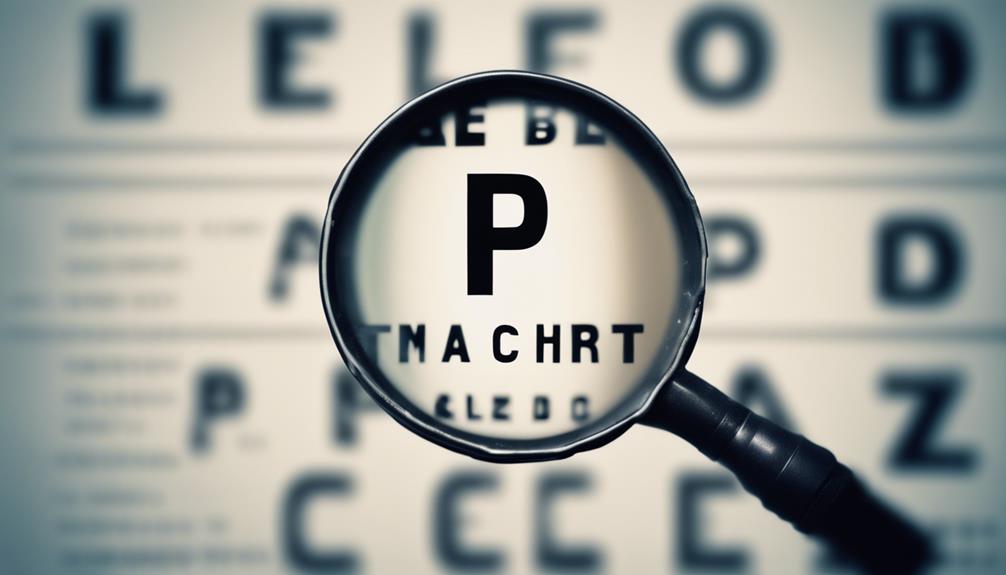Getting 20/40 vision means you see at **20 feet** what people with normal vision see at **40 feet**. This is a big deal during eye exams and affects how folks see the world. Reasons include eye issues and aging. Problems like nearsightedness and astigmatism happen a lot. Fixes like glasses or surgery can help. Things like eye exercises and **good food** matter too. The Snellen chart gets used in exams to check how well you see. Knowing about 20/40 vision shows how key it is to keep your eyes **in tip-top shape**.
Key Takeaways
- 20/40 vision means seeing at 20 feet what normal vision sees at 40 feet.
- Determined during eye exams using the Snellen chart.
- Commonly caused by refractive errors, aging, eye conditions, or injuries.
- Essential for tasks like driving and daily activities.
- Corrective measures include glasses, contacts, or surgery.
Definition of 20/40 Vision
Understanding 20/40 vision involves recognizing that it signifies seeing at 20 feet what a person with normal vision can see at 40 feet. When we look at objects, our eyes play an essential role in capturing images and sending signals to the brain for interpretation.
In this case, individuals with 20/40 vision experience less sharpness in their vision compared to those with 20/20 vision. This measurement is determined during the refraction test in an eye exam, where the clarity and sharpness of one's vision are assessed. People with 20/40 vision may benefit from prescription lenses to improve their visual acuity, aiding them in seeing more clearly.
Most states consider 20/40 as the minimum visual acuity required for an unrestricted driver's license, highlighting the importance of clear vision for activities like driving. Therefore, understanding the nuances of 20/40 vision is crucial in comprehending the impact it has on how we see the world around us.
Causes of 20/40 Vision

Refractive errors like nearsightedness and farsightedness, along with conditions such as astigmatism and presbyopia, can contribute to 20/40 vision.
Aging can also play a role in changes to the eye's focusing ability, leading to 20/40 vision.
Injuries, certain medications, and underlying health conditions are additional factors that may impact visual acuity, resulting in 20/40 vision.
Common Vision Problems
What common vision problems lead to 20/40 vision?
Common causes of 20/40 vision include refractive errors like nearsightedness, farsightedness, astigmatism, and presbyopia. These issues can result in a decrease in visual acuity to 20/40. Additionally, aging and changes in the eye's shape play a significant role in the development of 20/40 vision. Conditions such as cataracts or glaucoma may also lead to this level of visual impairment.
However, there are solutions that exist to address these problems. Consulting with an environmental psychologist can help identify the best solutions for improving vision. Corrective measures like glasses or contacts are often prescribed to enhance visual acuity for individuals with 20/40 vision.
Eye Health Factors
Eye health factors like refractive errors, eye conditions, age-related changes, injuries, and certain medications or health conditions can contribute to the development of 20/40 vision. Refractive errors such as myopia or hyperopia can lead to this visual acuity. Conditions like astigmatism or presbyopia may also play a role in causing 20/40 vision.
As we age, changes in our eyes' focusing abilities can result in this level of vision. Additionally, injuries to the eye can have an impact, as well as certain medications or health issues like diabetes. It's important to monitor our eye health regularly to detect and address these factors promptly. By understanding these causes, we can take proactive steps to maintain healthy vision.
Corrective Measures Available
Understanding the reasons behind 20/40 vision is essential in exploring the corrective measures available to address this visual acuity issue. When vision is referred to as 20/40, it means that what a person with 20/20 vision can see at 40 feet, someone with 20/40 vision needs to be at 20 feet to see.
Corrective measures available for 20/40 vision include prescription eyeglasses or contact lenses to compensate for refractive errors like nearsightedness, farsightedness, astigmatism, or presbyopia. In some cases, surgery such as LASIK may be recommended to correct the underlying issues causing 20/40 vision.
Regular eye exams are essential in identifying the specific causes of 20/40 vision and determining the most appropriate corrective measures to improve visual acuity.
Symptoms and Diagnosis

When experiencing 20/40 vision, common symptoms such as blurry vision, difficulty reading small print, and eye strain may manifest. If you find yourself experiencing these symptoms, it's important to seek a diagnosis through a thorough eye exam.
During this examination, an eye care professional will likely conduct a visual acuity test to assess your ability to see clearly at various distances. Eyestrain and headaches are often associated with 20/40 vision, making it essential to address any discomfort promptly.
Additionally, individuals with 20/40 vision may encounter challenges with night driving and reading road signs from a distance. A diagnosis of 20/40 vision indicates that objects may appear less clear when viewed from afar compared to those with normal vision.
Treatment Options Available

Treatment options for individuals with 20/40 vision include prescription lenses, such as glasses or contacts, which can greatly improve visual acuity. Some may opt not to wear corrective eyewear based on personal choice and lifestyle. For those seeking clearer vision, new glasses or contacts can enhance the sharpness of distant objects and text. It's essential to consider nutrient-dense foods that benefit eye health, especially for girls and women who may be more prone to vision issues. Big Ag can play a role in providing access to a variety of these foods. Below is a table summarizing key treatment options for 20/40 vision:
| Treatment Options | Description | Benefits |
|---|---|---|
| Glasses | Corrective lenses worn on the face. | Improve clarity of vision. |
| Contacts | Thin lenses placed directly on the eye. | Enhance field of view. |
| Nutrient-Dense Food | Foods rich in vitamins and minerals. | Support overall eye health. |
Impact on Daily Activities

Managing daily tasks can present challenges for individuals with 20/40 vision, impacting various aspects of their lives. Here are some ways in which 20/40 vision can influence daily activities:
- Difficulty reading road signs or recognizing faces at a distance can lead to safety concerns while driving.
- Watching TV or reading small print may require adjustments like sitting closer to screens or using magnifying tools.
- Engaging in sports or detailed work that demand sharp visual acuity can be hindered by 20/40 vision.
- Getting around unfamiliar environments or participating in activities requiring precise vision may require extra effort for those with 20/40 vision.
These challenges can sequester individuals with 20/40 vision from certain activities, affecting their involvement in tasks they've vested interests in. Finding strategies to overcome these obstacles is crucial to make sure that daily activities aren't overly impacted by the limitations of 20/40 vision.
Can 20/40 Vision Be Improved?

When considering improving 20/40 vision, it's important to explore vision correction options and lifestyle changes that can impact visual acuity positively.
Prescription lenses, such as glasses or contacts, can greatly enhance clarity for those with 20/40 vision. Optometrists can offer guidance on the most suitable corrective measures to help individuals with 20/40 vision improve their ability to see clearly.
Vision Correction Options
Improving 20/40 vision can be achieved through various vision correction options like prescription lenses. Here are some choices to contemplate:
- Eyeglasses: Prescription lenses in eyeglasses can enhance visual acuity for individuals with 20/40 vision.
- Contact Lenses: Contacts offer an alternative to glasses and can provide clear vision for those with 20/40 vision.
- Reevaluation: Regular appointments with optometrists are essential for evaluating and adjusting vision correction methods.
- Enhanced Clarity: Opting for new glasses or contacts can sharpen distant objects and text, improving daily activities.
Considering these options can help individuals with 20/40 vision experience improved visual clarity and quality of life.
Lifestyle Changes Impact
Implementing healthy lifestyle changes can positively impact 20/40 vision by enhancing overall eye health and potentially boosting visual acuity. By incorporating regular eye exercises, proper nutrition, and avoiding habits like smoking and excessive screen time, individuals can maintain excellent vision. Adequate hydration and sufficient sleep are also vital factors in supporting healthy eyes and potentially improving 20/40 vision. Consulting with an eye care professional for personalized recommendations and treatment options can play a significant role in addressing vision concerns. By putting these practices into place, individuals may see improvements in their vision over time. It's important to remember that changes may take time, with noticeable results potentially appearing within three years.
| Lifestyle Changes | Impact on 20/40 Vision |
|---|---|
| Eye exercises | Strengthen eye muscles |
| Proper nutrition | Maintain excellent vision |
| Avoiding smoking | Reduce eye strain |
| Limiting screen time | Support better vision |
| Hydration and sleep | Contribute to eye health |
Understanding Eye Exams for 20/40 Vision

In eye exams for 20/40 vision, optometrists typically assess visual acuity by having individuals read off a Snellen chart without any vision correction. Understanding the process can help demystify this important aspect of eye health.
- The Snellen chart is a standardized eye chart used to measure visual acuity.
- Optometrists determine 20/40 vision by comparing how well you see the chart at 20 feet to what someone with normal vision sees at 40 feet.
- The top number in 20/40 vision represents the testing distance, while the bottom number represents the distance at which a person with normal vision could read the same line.
- This measurement helps assess how clearly you can see objects at a specific distance compared to the average person.
Lifestyle Tips for Better Vision

To maintain peak eye health and improve vision, we prioritize consuming a diet rich in essential nutrients and following the 20-20-20 rule to reduce eye strain. Eating foods high in vitamins C and E, zinc, omega-3 fatty acids, and lutein supports eye health. Implementing the 20-20-20 rule—taking breaks to look at something 20 feet away every 20 minutes—helps alleviate eye strain caused by prolonged screen time.
Protecting our eyes from harmful UV rays is vital. Wearing sunglasses that block 100% of UVA and UVB rays can prevent vision damage. Regular exercise, like walking, improves blood circulation to the eyes, reducing the risk of age-related macular degeneration.
Staying hydrated throughout the day is essential for overall eye health. Dry eyes can lead to discomfort and vision problems. By following these lifestyle tips, we can make sure that our eyes stay healthy and functional. Vision is precious; without it, enough of us around the world would struggle to perform daily tasks.
Frequently Asked Questions
How Do You Interpret the Meaning of 20 20 Vision?
When interpreting 20/20 vision, we comprehend it as the ability to see at 20 feet what a person with normal vision sees at 20 feet.
It signifies clear vision without the need for corrective lenses, allowing one to distinguish 9mm letters at the standard distance.
This standard benchmark for good eyesight guarantees the clarity of details and objects at the typical viewing distance.
What Does 2040 Vision Mean?
20/40 vision means seeing letters on an eye chart at 20 feet as clearly as someone with normal vision sees them at 40 feet.
It indicates a decrease in visual acuity compared to 20/20 vision, with larger bottom numbers showing less sharp vision.
People with 20/40 vision may benefit from prescription glasses or contacts to enhance visual sharpness.
This level of vision might require corrective eyewear for driving, as objects or text can appear blurry at a distance.
What Does Twenty Twenty Five Vision Mean?
When we talk about twenty twenty-five vision, we're referring to the clarity of sight where objects at 25 feet are seen as clearly as someone with normal vision sees them at 20 feet.
This level of vision is better than 20/40 but not as sharp as 20/20 vision. It suggests good visual acuity but may require corrective lenses for peak focus.
It's like aiming for excellence but settling for very good.
What Does Twenty Thirty Vision Mean?
Twenty-thirty vision means seeing at 20 feet what those with normal vision see at 30 feet. It indicates a slight decline in sharpness compared to 20/20 vision. People with this vision may need corrective lenses for clearer sight.
This measurement assists optometrists in evaluating visual clarity. Twenty-thirty vision falls into mild refractive errors and is common among adults.
Is 20/40 vision a hindrance to watching videos or using video devices?
Having 20/40 vision may not necessarily hinder one’s ability to watch videos or use video devices, but it can certainly make the experience less enjoyable. However, as they say, “video killed the radio,” so it’s important to find ways to adapt and make the most of the visual content available.
Conclusion
To sum up, 20/40 vision is a common condition where objects appear blurry from a distance. It can be caused by various factors and may impact daily activities. Treatment options are available to improve vision, and regular eye exams are essential for monitoring changes.
Remember, 'An ounce of prevention is worth a pound of cure.' Following lifestyle tips and seeking professional help can help maintain good eye health and potentially improve vision for a brighter future.











